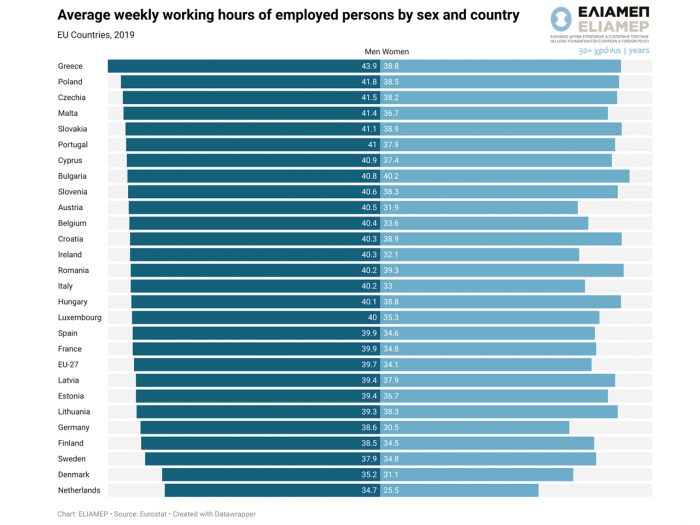The recent labor market reform in Greece brought the issue of working hours and overtime pay back to the fore. In this context, it is worth exploring the average working time for both sexes in EU countries.
The chart presents the latest available data (2019) from Eurostat on the average working hours per week for men and women in EU member states. The left side of the chart shows the average working hours for men, while on the right are those for women.
In the EU-27 as a whole, the average working week of employees in their main job is 37.1 hours for both sexes. Differentiating between sexes, the averages are estimated at 39.7 hours for men and 34.1 hours for women. Among EU member states, the longest average working week is in Greece (41.7 hours per week) and the shortest in the Netherlands (30.4 hours per week). In Greece, men work an average of 43.9 hours per week, in Poland 41.8 hours, in the Czech Republic 41.5 hours and in Malta 41.4 hours. Male employees in the Netherlands work an average of 34.7 hours a week. The country where women recorded the highest average weekly working hours is Bulgaria with 40.2 hours. This is the only EU Member State where the average is over 40 hours for women. Bulgaria is followed by Romania (39.3 hours per week), Slovakia and Croatia (38.9 hours per week), and Greece (38.8 hours per week). Women in the Netherlands work an average of 25.5 hours a week.
It is important to note that average working hours are affected by a number of factors. An important factor, for example, is the share of part-time workers and the participation rate of women in the labour force, as they have higher rates of part-time work than men. According to Eurostat data, the Netherlands records the highest proportion of part-time work for the same year (50.2%) with 27.2% for men and 75.2% for women, while Greece records the second lowest (9.1% overall, 5.8% for men and 10.9% for women) after Lithuania, which largely explains the big differences of average weekly working hours.
Finally, it should be clarified that more working hours do not necessarily translate into higher productivity. It may even be a result of, or even a factor for low labor productivity, since it may be linked to the low degree of capital intensity in the production process and the limited use of new technologies, or the application of inefficient organizational practices. As the chart shows, the EU’s most productive and competitive economies have the lowest weekly working averages.




